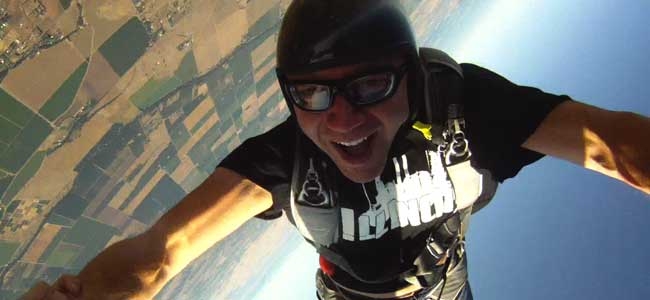Skydiving computer scientist T.J. Alumbaugh jumps into the new year
 (Download Image)
T. J. Alumbaugh jumping yet again out of a plane
(Download Image)
T. J. Alumbaugh jumping yet again out of a plane
"Formation skydiving is a great sport," Alumbaugh said. "It teaches teamwork and coordination, and you're always learning something new. Also, the intense adrenaline rush is a nice side benefit." Alumbaugh has been a licensed skydiver for almost three years. During that time, he has logged 235 skydives and has jumped out of everything from Cessnas to hot-air balloons to various turbo-prop planes.
"One of my favorite jumps was when I traveled with some friends to Perris, Calif.," Alumbaugh said. "It's a world-renowned drop zone, attracting skydivers from across the globe. We happened to be there at the same time as 150 Australians who had all come to set a new Australian free-fall record. We did a few jumps with them, one out of a hot-air balloon where we landed in a high school baseball field. They were fun people but totally and truly crazy."
As if hurtling himself out of planes wasn't satisfying enough, Alumbaugh decided he wanted to help other people hone their skydiving skills. He recently received his "coach rating," which means he can train student skydivers to check their equipment and perform emergency procedures. He also teaches free-fall skills, which are useful information skydiving.
On land, Alumbaugh is the computer science team leader of the Lab's KULL project and the project leader of the Automated Testing System project. KULL is a massively parallel, multiphysics simulation tool for the simulation of inertial confinement fusion. The KULL computer science team is responsible for solving several challenges that come with deploying a highly capable, complex physics simulation tool. For example, they develop software infrastructure components, give technical assistance to the code physicists, port their software to new compilers/architectures, and develop best practices for testing and release procedures.
The other part of Alumbaugh's job, the Automated Testing System, is an open-source Python testing tool that works well for command-line-based applications in HPC environments. The tool is deployed on major computing platforms at the Lab, Sandia, and Los Alamos.
Coming to work at the Lab was a natural progression for Alumbaugh after receiving two bachelor's degrees and a master's degree at the University of Illinois.
"After getting a B.S. in computer science, I became very interested in the numerical solution of partial differential equations and basically any overlap between computer science and mathematics," Alumbaugh said. "So I decided to stay an additional year to get a B.A. in math. The combination turned out to be a good foundation for getting my M.S. in computer science with an emphasis in computational science and engineering."
In addition to work and skydiving, Alumbaugh is very involved with his church community. Although Alumbaugh looked forward to visiting family and friends in Chicago and Atlanta for Christmas and New Year's, he was disheartened that his holiday travels derailed him from logging more jumps...until 2012.
-Deanna K Willis




